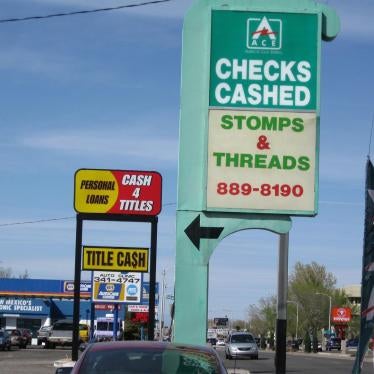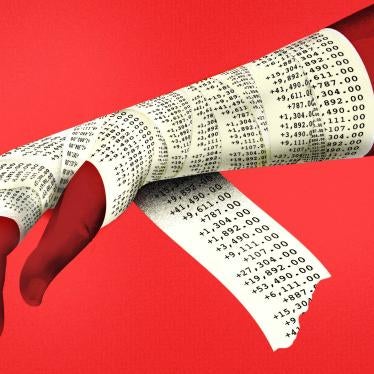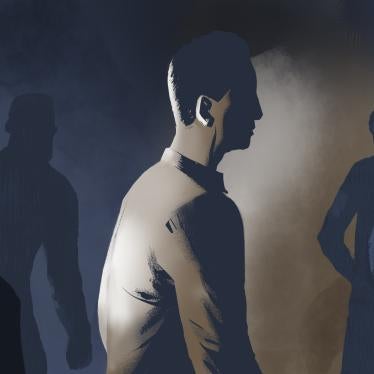Dear Speaker Pelosi, Majority Leader Schumer, Minority Leader McCarthy, Minority Leader McConnell, Chairwoman Waters, and Chairman Brown:
Human Rights Watch urges you to support joint resolution SJRes.15/HJRes.35, which would use the Congressional Review Act to repeal the Office of the Comptroller of the Currency (OCC) rule, “National Banks and Federal Savings Associations as Lenders.”
This OCC rule, which was enacted by the administration of former President Donald Trump and came into force in December 2020, changes the definition of bank loans, which are largely exempt from state-based interest rate caps, to include any loan agreement for which a federally chartered bank is named as the lender.[1] If Congress does not act, this rule’s simple change in language will have profound consequences for millions of Americans, resuscitating predatory “Rent-A-Bank” schemes, undermining vital legal protections in almost every state, and expanding opportunities for unscrupulous lenders to prey upon the most vulnerable communities in the United States.
Human Rights Impacts of Predatory Lending
The Covid-19 pandemic has exacerbated and exposed the already immense disparities in income and wealth that exist between Americans.[2] At the end of 2019, US households held an astonishing 43.6 percent of all global financial assets.[3] During the first 11 months of the pandemic, the total net worth of billionaires in the United States grew by 44 percent or $1.3 trillion while an additional 110 people became new billionaires in the US.[4]
Things are much, much more challenging for those at the other end of the income spectrum. The Congressional Budget Office forecasts that the nation’s unemployment rate will stay above pre-pandemic levels through the rest of the decade.[5] Full-time minimum-wage workers cannot afford a one-bedroom rental at fair market rent in 95 percent of the country.[6] Despite efforts to provide a financial safety net for Americans who are struggling through the pandemic, nearly one-third of people in the US do not have enough in savings to cover an unexpected cost of four-hundred dollars, and 15 percent cannot pay their monthly bills.[7]
For these people, paying for an unexpected expense, like auto repairs or paying for a child’s medical emergency, requires a loan since income and savings do not suffice.
Payday and other non-bank lenders have filled the need for small-dollar, accessible credit for millions of Americans but at a very, very high cost. Approximately 12 million people take out payday loans each year, and there are more than 16,000 payday lender locations across the country, predominantly in low-income neighborhoods and communities of color.[8]
Unfortunately for many people who are placed in the position to borrow from these small-dollar and short-term lenders, the extortionate interest rates and fees that can accompany these “small loans” show just how expensive it is to be poor in the United States.
Research from the Pew Charitable Trusts has found that the average payday loan customer borrows just $375, but ends up paying an additional $520 in fees alone.[9] In part, this is because the average borrower would have to sacrifice 36 percent of their next paycheck to pay off a loan of this size.[10] For people who already did not have enough to cover $375 in expenses to begin with, sacrificing more than one-third of a paycheck may not be possible.
The consequences of failing to pay off such a loan can be dire. The triple-digit interest rates that can accompany these loans may easily trigger a downward spiral of indebtedness, where people continuously roll-over and refinance, incurring more and more fees while falling further and further into debt.[11] This cyclical debt trap is evident in the data: in 2014, the Consumer Financial Protection Bureau found that 80 percent of payday loans were taken out within two weeks of a previous payday loan.[12]
This problem has deep roots. Nearly a decade ago, Human Rights Watch documented the impacts of predatory payday lending in some of the poorest parts of the United States: Native American reservations.[13] Our research in South Dakota and New Mexico showed that a disproportionate number of people living on reservations depended on short-term loans to meet unexpected expenses.
As part of that research, in 2012, Human Rights Watch conducted interviews with nearly 400 people on reservations around the country. More than half reported having trouble repaying a payday loan, and over 70 percent found that the loan repayment process made covering regular household expenses more difficult.[14] Some even found themselves having to forego food or delay paying rent and utilities to afford their loan payments.[15] While these findings are from several years ago, the health and economic impacts of the Covid-19 pandemic have hit Native American and Alaskan Native communities particularly hard, likely exacerbating these troubling trends.[16]
Access to fair credit is vital for many Americans to meet their most basic needs. But Americans should be able to take a loan to cover an emergency—or even an everyday expense—without fees and interest rates entangling them in perpetual debt or forcing them to choose between repayment and food. Luckily, there is a simple and effective solution.
The OCC Rule Undermines Protections for Borrowers
Interest rate caps can protect people who borrow “small loans” from this downward spiral into indebtedness.[17] Rate limitations of some kind are now in place in over 43 states and in the District of Columbia, including both South Dakota and New Mexico, which implemented protections for borrowers like those Human Rights Watch interviewed on Native American reservations.[18]
As of March 2021, 18 states and the District of Columbia cap interest rates and fees for payday loans at 36 percent.[19] These and other state-based interest rate caps on small-dollar and short-term loans are crucial protections for borrowers.[20] But if the OCC rule comes into effect, these laws would be rendered toothless by opening the door to so-called “Rent-A-Bank” schemes.[21]
In their various forms, these schemes require a partnership between a non-bank lender—like a payday or auto-title lender—and an OCC-regulated national bank or federal savings association, which are largely exempt from state-based interest rate caps.[22] Under the OCC rule, any loan agreement would also be exempt from these state-based interest caps if an OCC-regulated bank is named as the lender in the loan agreement—regardless of whether a non-bank lender arranged for the loan, will profit from the loan, or will seek repayment from the borrower.[23]
Rather than following the money, the OCC rule bakes in a willful ignorance towards the actual origin and purpose of loan agreements, allowing payday and other small-dollar and short-term lenders to sidestep interest rate caps by having an OCC-regulated bank serve as an intermediary between them and borrowers. In turn, this allows non-bank lenders to ignore financial protections enacted in almost every state, charge extortionate interest rates, and trap vulnerable consumers in this devastating cycle of debt.
Support the Congressional Review Act Challenge of the OCC Rule
While more federal action is needed to help lift the low-income borrowers of short-term loans out of poverty or precarity, closing regulatory loopholes like the one created by the OCC rule is a crucial step toward reducing exploitation of the economically vulnerable and protecting their human rights.
The OCC rule will expand opportunities for unscrupulous lenders to prey upon the most vulnerable communities in the United States. That Congress would allow this rule to go into effect during an ongoing public health and economic crisis that has disproportionately impacted these same communities would be particularly cruel.
Shutting off this pathway for predatory lenders to evade caps placed on their interest rates will help prevent people from falling into debts that they can never afford to repay, sparing Americans from having to choose between paying down a loan or putting food on the table.
We urge Congress to use the Congressional Review Act to prevent this from happening. Passing the joint resolution (SJRes.15/HJRes.35) is a simple step that will have an outsized positive impact on the lives of Americans throughout the country.
We would be happy to provide additional information, and also welcome the opportunity to further discuss this issue. If you would like to arrange such a meeting, please contact Namratha Somayajula (somayan@hrw.org).
Sincerely,
Arvind Ganesan
Director, Business and Human Rights
Human Rights Watch
[1] Office of the Comptroller of the Currency, “National Banks and Federal Savings Associations as Lenders,” Treasury, 85 Fed. Reg. 68742-68747, 68747, https://www.federalregister.gov/documents/2020/10/30/2020-24134/national-banks-and-federal-savings-associations-as-lenders at “Part 7—Activities and Operations”.
[2] Juliana Menasce Horowitz, Ruth Igielnik, and Rakesh Kochhar, “Most Americans Say There Is Too Much Economic Inequality in the U.S., but Fewer Than Half Call It a Top Priority,” Pew Research Center, January 2020, https://www.pewresearch.org/social-trends/wp-content/uploads/sites/3/2020/01/PSDT_01.09.20_economic-inequailty_FULL.pdf, pp.12-22 (finding that the median wealth of the American family in 2016 was below what it was in 1998; and that during this period, only upper-income families saw an increase in their median net worth, middle-income families net worth shrank by 20%, and low-income families’ net worth declined by a whopping 45% percent).
[3] Allianz Research, “Alliance Global Wealth Report 2020,” September 23, 2020, https://www.allianz.com/content/dam/onemarketing/azcom/Allianz_com/economic-research/publications/specials/en/2020/september/2020_09_23_AllianzWealthReport2020.pdf at 10.
[4] Compare (i) Americans for Tax Fairness, “Growth in Total Wealth of U.S. Billionaires During the Pandemic,” March 18, 2021. http://americansfortaxfairness.org/billionaires/ at “Total Number of U.S. Billionaires 1990-2020” (finding 614 billionaires in the United States in March 2020, and that “total wealth of U.S. billionaires grew by $1.3 trillion during the roughly first eleven months of the coronavirus pandemic -- a 44% spike in wealth”); and (ii) “World’s Billionaires List,” Forbes (2021). https://www.forbes.com/billionaires/ (finding 724 billionaires in the United States in 2021).
[5] Congressional Budget Office, “An Overview of the Economic Outlook: 2021 to 2031,” February 2021, https://www.cbo.gov/system/files/2021-02/56965-Economic-Outlook.pdf (predicting the annual average unemployment rate to remain at 4.1% between 2026 and 2031, and finding the actual 2020 unemployment rate to be 8.1%). See also Congressional Budget Office, “The Budget and Economic Outlook: 2020 to 2030,” January 2020, https://www.cbo.gov/system/files/2020-01/56020-CBO-Outlook.pdf (listing the 2019 unemployment rate at 3.7%, and predicted a 2020 unemployment rate of 3.5%).
[6] National Low Income Housing Coalition, “Out of Reach: The High Cost of Housing,” 2020, https://reports.nlihc.org/sites/default/files/oor/OOR_2020_Mini-Book.pdf at 4 (“In only 5% of all U.S. counties (144 counties out of more than 3,000 nationwide, not including Puerto Rico) can a full-time minimum-wage worker afford a one-bedroom rental home at fair market rent.”)
[7] Board of Governors of the Federal Reserve System, “Report on the Economic Well-Being of U.S. Households (SHED), Update on the Economic Well-Being of U.S. Households: July 2020 Results,” 2020, https://www.federalreserve.gov/publications/2020-update-economic-well-being-of-us-households-overall-financial-security.htm at “Overall Financial Security” (“85 percent of adults said they could pay all their current month's bills in full in July”), “Table 4” (finding that 70% of survey respondents Would cover a $400 emergency expense completely using cash or its equivalent in July 2020).
[8] The Pew Charitable Trusts, “Fact Sheet: Payday Loan Facts and the CFPB’s Impact,” May 2016, https://www.pewtrusts.org/-/media/assets/2016/06/payday_loan_facts_and_the_cfpbs_impact.pdf (“Twelve million Americans take out payday loans each year, spending $9 billion on loan fees”); “State Research Shows That Payday Lending Stores Are Heavily Concentrated In African American and Latino Communities Across California,” Center for Responsible Lending (9 December 2016). https://www.responsiblelending.org/media/state-research-shows-payday-lending-stores-are-heavily-concentrated-african-american-and; The Pew Charitable Trusts, “RE: RIN 3064-ZA04 (Request for Information on Small-Dollar Lending),” January 18, 2019, https://www.fdic.gov/regulations/laws/federal/2018/2018-small-dollar-lending-3064-za04-c-015.pdf at 6.
[9] The Pew Charitable Trusts, “RE: RIN 3064-ZA04 (Request for Information on Small-Dollar Lending),” January 18, 2019, https://www.fdic.gov/regulations/laws/federal/2018/2018-small-dollar-lending-3064-za04-c-015.pdf at 6. Payday lenders are not alone in this, however. See The Pew Charitable Trusts, “Federal Bank Regulators Encourage Small Loans in Response to COVID-19,” April 22, 2020, https://www.pewtrusts.org/en/research-and-analysis/articles/2020/04/22/federal-bank-regulators-encourage-small-loans-in-response-to-covid-19 (finding that the typical cost of $400 borrowed over 3 months from a payday lender is $360; $400 in an auto title loan would cost a borrower $300 on average over this period, while pawn loans would cost $240).
[10] The Pew Charitable Trusts, “RE: RIN 3064-ZA04 (Request for Information on Small-Dollar Lending),” January 18, 2019, https://www.fdic.gov/regulations/laws/federal/2018/2018-small-dollar-lending-3064-za04-c-015.pdf at 6.
[11] Consumer Financial Protection Bureau, “CFPB Finds Four Out Of Five Payday Loans Are Rolled Over Or Renewed,” March 25, 2014, https://www.consumerfinance.gov/about-us/newsroom/cfpb-finds-four-out-of-five-payday-loans-are-rolled-over-or-renewed/.
[12] Consumer Financial Protection Bureau, “CFPB Finds Four Out Of Five Payday Loans Are Rolled Over Or Renewed,” March 25, 2014, https://www.consumerfinance.gov/about-us/newsroom/cfpb-finds-four-out-of-five-payday-loans-are-rolled-over-or-renewed/.
[13] See Arvind Ganesan, “Predatory Lending and Indian Country,” commentary, Human Rights Watch dispatch, September 24, 2013, https://www.hrw.org/news/2013/09/24/predatory-lending-and-indian-country (“we surveyed almost 400 people on reservations around the country about predatory borrowing”).
[14] Human Rights Watch, Payday Lending Survey Data (Cheyenne River and Pine Ridge Reservations in South Dakota, and Laguna and Zia Pueblos in New Mexico), July-November 2012.
[15] Komala Ramachandra, “US Congress Should End Extortionate Interest Rates,” Human Rights Watch dispatch, January 22, 2020, https://www.hrw.org/news/2020/01/22/us-congress-should-end-extortionate-interest-rates.
[16] See e.g., Hatcher, Agnew-Brune, Anderson, et al., “COVID-19 Among American Indian and Alaska Native Persons — 23 States, January 31–July 3, 2020,” Centers for Disease Control and Prevention, 2020 Morbidity and Mortality Weekly Report No.69, 1166-1169, August 28, 2020, https://www.cdc.gov/mmwr/volumes/69/wr/mm6934e1.htm?s_cid=mm6934e1_w (“cumulative incidence of laboratory-confirmed COVID-19 among AI/AN persons was 3.5 times that among non-Hispanic white persons”); Casey Lozar, “Structural barriers to tribal revenues leave Indian Country vulnerable to COVID-19 pandemic,” Federal Reserve Bank of Minneapolis, Center for Indian Country Development, March 4, 2021, (“Many tribally owned enterprises are concentrated in sectors such as gaming and entertainment that have been disproportionately affected by social-distancing measures. After initial shutdowns and many partial re-openings to protect against the spread of the virus, over half of tribally owned enterprises reported revenue losses of more than 20 percent in a fall 2020 CICD survey. As a result of the losses, enterprises have fewer revenues to allocate to tribal governments, which then have had to reduce both the essential services they provide their communities and the investments they make in critical public infrastructure”).
[17] For a discussion of the history and efficacy of interest rate caps on payday and installments loans, see Lauren K. Saunders, “Why 36%? The History, Use, and Purpose of the 36% Interest Rate Cap,” National Consumer Law Center, April 2013, https://www.nclc.org/images/pdf/pr-reports/why36pct.pdf.
[18] In 2017, South Dakota implemented an interest rate cap of 36 percent for short-term loans; New Mexico followed in 2018 with a 175 percent interest rate cap on small loans of less than $5000. See Liz Farmer, “Facing 652% Interest Rates, South Dakota Voters Regulate Payday Lending,” Governing, November 9, 2016, https://www.governing.com/topics/elections/gov-south-dakota-payday-lending-ballot-measures.html; Statement of Rules Changes Related to Licensees under the Small Loan Company Act of 1955 (SLA) and Changes Made from the Proposed Rules to the Final Adopted Rules, New Mexico Regulation and Licensing Department Financial Institutions Division, September 15, 2018, http://www.rld.state.nm.us/uploads/files/FID%20Statement%20of%20Small%20Loan%20Rules%20Changes%2009-14-18%20-final.pdf. See also “State Annual Percentage Rate (APR) Caps For $500, $2,000 and $10,000 Installment Loans,” National Consumer Law Center, 2019, https://www.nclc.org/images/pdf/high_cost_small_loans/fact-sheet-apr-caps-for-installment-loans.pdf.
[19] “Map of U.S. Payday Interest Rates,” Center for Responsible Lending, March 23, 2021. https://www.responsiblelending.org/research-publication/map-us-payday-interest-rates.
[20] See generally The Pew Charitable Trusts “RE: RIN 3064-ZA04 (Request for Information on Small-Dollar Lending),” January 18, 2019, https://www.fdic.gov/regulations/laws/federal/2018/2018-small-dollar-lending-3064-za04-c-015.pdf; Center for Responsible Lending, “The Sky Doesn't Fall: Life After Payday Lending in South Dakota,” January 13, 2020, https://www.responsiblelending.org/research-publication/sky-doesnt-fall-life-after-payday-lending-south-dakota.
[21] For additional discussion on how third-party lending relationships can negatively impact borrowers, see The Pew Charitable Trusts, “RE: OCC Proposed Rule on National Banks and Federal Savings Associations as Lenders Docket OCC‐2020‐0026,” September 3, 2020, https://www.pewtrusts.org/-/media/assets/2020/09/pew_occ-2020-0026_3sep20_final-signed.pdf at 2-5.
[22] The National Bank Act (12 U.S. Code § 85) exempts federally chartered banks from state-based interest rate caps. See Federal Deposit Insurance Corporation, “General Counsel's Opinion No. 10; Interest Charges Under Section 27 Of The Federal Deposit Insurance Act,” General Counsel’s Opinion, April 20, 2014, https://www.fdic.gov/regulations/laws/rules/5500-700.html (discussing National Bank Act and the OCC’s interpretations). For more information on these types of loans, see “Rent-A-Bank Loans,” National Consumer Law Center (2021) https://www.nclc.org/issues/high-cost-small-loans/rent-a-bank.html; Center for Responsible Lending “The Rent-A-Bank Scheme,” February 4, 2021, https://www.responsiblelending.org/RentABank. For more information on OCC charters and licensing, see Office of the Comptroller of the Currency, “Charters & Licensing,” 2021, https://www.occ.treas.gov/topics/charters-and-licensing/index-charters-licensing.html.
[23] “National Banks and Federal Savings Associations as Lenders,” Office of the Comptroller of the Currency, Treasury, 85 Fed. Reg. 68742-68747, 68747. https://www.occ.gov/news-issuances/federal-register/2020/85fr68742.pdf (“a bank makes a loan when the bank, as of the date of origination: (1) Is named as the lender in the loan agreement”).







